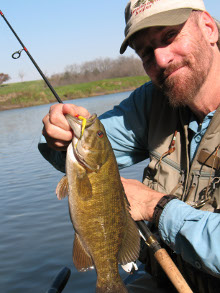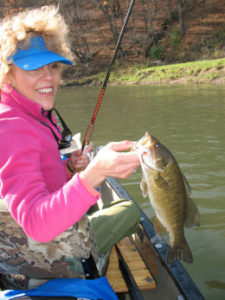
In fishing there’s no such thing as “Fall.” There are actually 3 different falls.
“FALL FISHING FRENZY! SUPER FALL ACTION!” Over the decades, I’ve seen a multitude of magazine articles with titles like these, raving about fall smallmouth bass fishing. And it’s true. At times, fall can offer some of the most spectacular fishing of the year. However, many articles touting fall smallmouthing are so simplistic, so generic or downright misleading that they’re largely worthless. Not this one. Grounded in biology and extensive research, this article isn’t generic hype. Let’s look at fall as it actually occurs.
First of all, in fishing there’s no such thing as “Fall”. There are actually 3 falls– three distinct periods, each with its own characteristics and dynamics. Secondly, there’s no such thing as “a smallmouth river.” There’s a great diversity of smallmouth bass rivers across North America, and fall fish act quite differently based on each specific river’s hydrology and climactic zone. Third, fall fishing is much more weather-dependent than summer smallmouthing. This all means that to be consistently successful, a late-season angler needs to understand the 3 falls of smallmouth bass for the specific rivers he or she fishes.
#1– Early Fall Period
The first fall is generally the period that writers mean when they hype “fast fall fishing.” Water temperatures are still relatively warm (above 57 degrees) but food sources are declining, and the smallmouth bass’s energy requirements are high because of developing gonad production. Plus, lower light intensity makes fish less wary. This can all add up to those “died and gone to heaven” days that smallie fans fondly recall years later. I’ve had plenty of days with exceptionally high number of fish, and I have also seen many big fish caught during the early fall period.
Depending on the latitude and that year’s weather, the early fall period can occur anywhere from early September to early October. One big change from summer is the smallies’ switch from crayfish to a minnow diet. They will still eat some craws, but on most waters cooler temps make crayfish less active and available. Plus crayfish quit molting, so they’re hard-shelled and less appealing. But minnows, including shiners and chubs (and even shad in some rivers) are now good eating size and readily available, so smallmouth bass increasingly focus on them. Especially when the water is still 60 degrees or more, these minnow-chasing bronzebacks sometimes nail topwaters with gusto. However, early fall surface fishing isn’t as sure a bet as it is in summer. Instead, fish often want you to mimic the motion of darting minnows.
When early-fall smallies are pursuing minnows in river runs and heads or tails of pools, the mid-depth “Minnow Swing,” is unsurpassed. I describe this technique in detail in the book, River Smallmouth Fishing, and I demonstrate it in the video Stream Smallmouth Fishing. Here’s the short version. Simplified, the Swing is casting across and down, giving the lure extra animation as the moderate current pulls it downstream. Various minnow-resembling baits can work. Suspending thin-minnow crankbaits are often excellent. Shorter flukes can be very good, so can in-line spinners, and even bucktail jigs can sometimes produce. All of these lures should be lightweight or shallow-running enough so they don’t easily hang bottom. As the current slowly pulls your lure downstream, you give the lure extra action with short rod-tip twitches. The intent is to make the lure appear like an upstream-facing minnow darting and hovering in the current. Try different retrieves to learn what the fish want that day. Sometime it’s several short twitches in quick succession, other times it’s longer pauses between the rod-tip action. Nuancing your retrieves will pay off in more strikes.
# 2– Mid Fall
As rivers cool below 57 degrees, dramatic changes in smallmouth bass behavior occur. In shallower waterways across the northern portions of the species’ range, smallmouth actually migrate. Abandoning their summer haunts, fish may travel many miles downstream to slack-water hibernacula, where they will overwinter. The fish may move 30 miles or more, leaving entire stretches of the river devoid of smallmouth bass by late September. On some northern U.S. and Canadian rivers, migrating fish congregate in slow, deep pools. In other places, they move downstream into reservoirs created by blocking dams.
In the southern two-thirds of their range, riverine smallmouth generally don’t stage such striking fall movements. In these slightly warmer latitudes, fish concentrate rather than migrate. They abandon fast-flowing runs, and even shallow pools, and instead concentrate in slow pools and slack-water eddies. These locations are where fish will spend the frigid winter months, expending as little of their energy as possible as they wait for spring. Obviously, anglers should adapt to these changes in smallmouth bass locations. If you don’t figure out where mid-fall smallies go in a particular stream, or you could be fishing over empty water.
Besides figuring out where mid-fall smallies go in a particular stream, another major factor is the day-to-day weather. A couple days of warm, sunny weather can elevate water temperatures from a frigid 48 to a relatively toasty 54 degrees in the afternoon. This often also leads to an excellent bite, with big fish seeming to strike with reckless abandon. Conversely, a cold front or cloudy, rainy weather makes temps plummet and gives the fish a severe case of lockjaw. So try to hand-pick your fishing days in the second fall; a day of warmer, or at least stable, temperature is much better than a cool day.
When you do hit the river, target the slower-flowing areas, and make sure you keep your lure slow and deep. With their decreasing metabolic rate, bottom-hugging fish won’t rise far or move fast. This is the time when the “Crayfish Hop” technique really shines. (This technique is described in River Smallmouth Fishing and demonstrated in the video Stream Smallmouth Fishing) really shines. Don’t worry about the absence of crayfish. This Crayfish Hop is simply retrieving a jig slowly along the bottom with short hops.
One of my favorite fall lures for this deadly method is a white or yellow hair jig with a head just heavy to reach bottom, often just a 1/16th-ouncer. With this bait, you can effectively work the bottom of 5-foot-deep slack-water pools. Certainly, other colors also produce in mid-fall, but white and yellow are two of my favorites.
Because mid-fall smallmouth bass can be so highly concentrated, catches of a dozen smallies from a spot hardly larger than a bathtub are possible. Many times, I’ve gotten strike after strike in a single small spot. Better yet, many of these strikes are larger fish. Why do the big fish hit better? One explanation offered for the disproportionate number of smallies over 15 inches caught in the late season is that the smaller bass’ metabolism slows quicker in cold water than it does for bigger smallmouth. So even though you may be casting through a pod of a dozen small fish and just 5 larger ones, the big boys are the ones still actively feeding.
#3– Late Fall

This late fall smallmouth bass
fell for the “Float ‘n Fly” technique.
It may surprise some, but the Third Fall has become one of my favorite times to fish. Late-season days are short, the topwater bite is only a memory, the leaves are gone, but so are other anglers. Once the water dips into the 40s I have many streams all to myself. If you fish on the right days and in the right way, (that is, if you don’t mind bundling up and fishing exceedingly slow) end-of-fall smallmouth bass fishing can be truly impressive.
When temps are in the mid- or low 40s, the smallmouth bass’ metabolic rate is very slow and the fish often hover right on the bottom in the slackest water of that stretch of the river. This is the time to use the “Float ‘n’ Fly” technique. With this method, you suspend a weighted jig (“fly”) right off the bottom below a small bobber (“float”). This type of slow, specialized fishing likely won’t interest everyone. But I enjoy it because of the solitude, and because it’s often the last smallmouthing I do before full winter sets in. Honestly, I like catching big bronzebacks even when they don’t jump and mostly tussle near the bottom.
In fact, on a warm November or early December day when there has been a small spike in water temps (say from 44 to 47), that wonderful 5 hours from 11AM to 4PM can produce dozens of hefty bronze. Thirty- and 40-fish days are not unusual this time of year, if you have correctly targeted the winter hibernacula and you are fishing slow and deep enough. Using a good cold-water jig helps, too. A bucktail is okay, but one made with craft hair is better. Craft hair pulsates even when it’s nearly motionless, and when the water is frigid, just barely moving the lure is the ticket. Suspending a white or yellow 1/16th-oz. jig below a float in a 5-foot-deep pool is easy. I also use the Float ‘n’ Fly technique in deeper water. By increasing the jig weight to 1/8th ounce and using a 7 1/2 or 8-foot rod, I can fish 8-foot-deep water.
By all means, anglers should get out there and enjoy some late-season smallmouthing. While doing so, consider how your state can protect these concentrated, vulnerable fish. Increasing numbers of guys are targeting fall smallies, and even winter smallies. Some are keeping their larger fish. Recognizing this growing danger of over-harvest, a decade ago Minnesota was proactive and enacted catch-and-release-only smallmouth bass fishing after mid-September. Why not your state, too?


Great Article Tim–I just got your book in the mail this last week….very nice! Seems like you compose the book/DVD in a way that you really get the full benefit from both; I wouldn’t recommend that someone buy only either the book or DVD–I recommend they get them both. Fall fishing for Smallmouths here in the Ozarks is amazing. The early & mid fall period here last for quite some time…and I love it 🙂 Cheers!